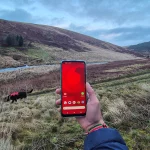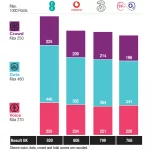BSG Study Examines Gigabit Broadband for Remote UK Rural Areas

The Broadband Stakeholder Group, which is a think-tank that advises the UK Government, has today published new research from Analysys Mason that examines some of the commercial and technical practicalities of providing faster broadband coverage to areas in the UK that are hardest to reach.
Just to recap. The Government’s new £5bn Project Gigabit programme, which is being overseen by their Building Digital UK team, aims to help further improve the picture for gigabit speed connectivity by using state aid to target connectivity improvements toward the final 20% of hardest to reach premises (i.e. helping to extend gigabit coverage to at least 85% of UK premises by the end of 2025). One forecast last year predicted that the UK could reach 98%+ with such services by 2030 (here).
However, Project Gigabit has long recognised that tackling those who live in so-called “Very Hard to Reach” (VHtRPs) areas would be “prohibitively expensive” (here and here). The current expectation is that, once the existing programmes have completed, around 0.3% of premises (under 100,000 homes and businesses) could still fall into this group.
Advertisement
The Government are currently consulting on how to tackle this and have already thrown around some ideas, such as greater used of Fixed Wireless Access (FWA), 4G (i.e. Macrocell FWA) and GEO or LEO based satellite broadband networks. On that last point, SpaceX’s LEO Starlink service is already technically available (albeit not exactly cheap) and BT recently signed a deal with OneWeb, which could result in something similar (here).
The Analysys Mason Report
The new report is focused more on the commercial and technical practicalities of providing faster broadband coverage to such areas. We should point out that the focus here tends to be less on providing gigabit speeds and more on the ability of different technologies to deliver either 30Mbps or 300Mbps download speeds.
The general conclusions for each technology examined can be found below, which probably won’t surprise anybody with a familiarity of what is being discussed. We should add that FTTP is also considered, despite being hugely expensive for such areas (i.e. less likely to play a big role in that final 0.3%), and they also looked at High-altitude platform systems (HAPS), which are a somewhat unproven area for commercial delivery (i.e. don’t expect this to be one of the solutions).
Conclusions by Technology
FTTP
▪ FTTP is the most futureproof of the technologies (easily capable of 1Gbit/s and beyond), but also the most expensive▪ Due to the very long line lengths in the final 100,000, up-front costs are significant, but opex is also potentially higher than the available revenue
▪ Deployment in the final 100,000 may require both a large up-front subsidy and ongoing subsidy to make any project viable.
▪ Potential solutions could include reducing some of the barriers to deployment (increasing infrastructure re-use, lowering deployment costs through new techniques) and/or combining the final 100 000 premises with other more profitable locations
Macrocell FWA [4G]
▪ The applicability of macrocell FWA depends strongly on the level of speed to be delivered▪ At 30Mbit/s, re-use of existing macrocells can provide a cost-effective and viable solution. However, this result assumes that the [Shared Rural Network] project will continue (and that these sites are effectively paid for and can be used for FWA too), and does not consider the very most rural 0.1% of the UK, which the SRN would not reach and would require new ultra-rural sites
▪ At 300Mbit/s, the extra equipment and new sites make macrocell FWA unsuitable for reaching VHtRPs: the lower cell radius (required to provide higher speeds) and low premises density make this option the least viable in almost all areas including final 100 000 premises
▪ We note that macrocell FWA is likely to be able to play more of a role in other rural areas (e.g. less rural areas than final 100 000 areas)
LOS [Line of Sight] FWA
▪ Using a similar architecture to FTTP, but replacing part of the final connection with wireless, LOS FWA provides a more cost-effective alternative to FTTP when offering 300Mbits. According to our commercial analysis, LOS FWA is the most cost-effective solution for providing 300Mbit/s to 70–90% of the final 100 000 premises (depending on the investment timeframe)▪ We note that should the requirement be pushed up to 1Gbit/s (which is not part of the scope of this study), the costs of FTTP and LOS FWA may become more similar
GEO satellites
▪ GEO satellites are established, commercially viable solutions for providing ultra-rural connectivity, and can be used today to provide a connection when no other is available▪ However, the end-user experience has limitations, including limits on maximum speed, high latency and usage/download speed restrictions
LEO satellites
▪ LEO satellites appear to be the most cost-effective solution for providing 300Mbit/s to the final 10 000–30 000 of the final 100 000 premises▪ However, the technology and commercial offers are still being developed (including the wholesale bandwidth costs, contention ratios, and whether users will face usage limitations over the medium term), and may require ongoing subsidy if users are not expected to pay twice as much as for other broadband technologies
High-altitude platform systems (HAPS)
▪ HAPS is expected to reach commercial deployment during 2021–27, but no commercial data was available at the time of writing▪ The technology remains an interesting option for covering ultra-rural areas, and its development should be carefully monitored
Overall, macrocell FWA technology comes out looking like the lowest cost option for 30Mbps speeds, while at 300Mbps a LOS FWA network looks best up to a point, after which LEO satellites tend to take over as the best fix.
Advertisement
Suffice to say that the Government’s future policy is unlikely to end up using a single technology to solve this problem, but HAPS, FTTP and GEO look less and less like viable contenders due to their caveats. But whatever they do, it will require some public funding to support delivery and or take-up by consumers.
Stephanie Liston, Chair of BSG, said:
“We are pleased to respond to the Government’s Call For Evidence on improving connectivity for Very Hard to Reach premises. We thank Analysys Mason for their contribution to the ongoing technology and policy debate. We have seen the significant need in the UK for digital services throughout the pandemic. As we enhance and rebuild our economy, the need for ubiquitous broadband coverage is essential. We look forward to contributing to Government’s support of all aspects of digital connectivity.”
The report finishes with a series of very generalised recommendations.
The Recommendations
▪ The Report reinforces the fact that, although there are technologies that could deliver in these areas, none is expected to be commercially viable to do so. Consequently, deployment would require some form of public financial intervention for these technologies to be deployed in very hard to reach areas. The BSG encourages the Government to seize the opportunity to consider innovative approaches to fully support this ambitious programme. For example, (i) procurements would need to define large enough blocs to allow network providers to scale effectively; (ii) public funding should be allocated for both capital and operational expenditures, including ongoing funding of satellite monthly rental.
▪ While most of the Very Hard to Reach Premises have similar characteristics (i.e. geographic isolation), there is great diversity between each of them. Some premises are located at a substantial distance from any neighbouring premises and/or any existing network, whilst others are located on islands. A mix of technologies will therefore be required. We believe the approach to be followed by the Government must be technology agnostic.
▪ The Government will also want to consider how services are delivered in areas where nearby premises are already benefiting from enhanced connectivity. We believe it may be possible to utilise nearby infrastructures to help reach Very Hard to Reach Premises.
▪ Where there is an overlap between remaining mobile Total Not-Spots and Very Hard to Reach Premises, the BSG suggests addressing mobile and broadband coverage issues at the same time.
▪ The BSG urges the Government to continue tackling existing barriers that impede the roll-out of new terrestrial infrastructures. Ambitious reforms to lower the cost and speed up the process of building and upgrading digital infrastructures including backhaul capacity are critical to allow stakeholders to increase the footprint of their commercial deployment. Examples include wayleaves, permits and land rents. These interventions would potentially reduce the number of premises within the very hard to reach category. An effective subsidy programme will be achieved for very hard to reach areas when the relevant policies that are developed address these existing barriers as well as the fundamental national needs of accessibility, reliability and resilience.
▪ The stated Government policy and subsidies so far have focused almost exclusively on gigabit speed. We believe that businesses and consumers value the other aspects of digital connectivity at least as much as they value speed. In particular, the BSG recommends that (i) availability, (ii) accessibility, (iii) reliability and (iv) resilience of digital services are addressed, as well as speed.
Mark is a professional technology writer, IT consultant and computer engineer from Dorset (England), he also founded ISPreview in 1999 and enjoys analysing the latest telecoms and broadband developments. Find me on X (Twitter), Mastodon, Facebook, BlueSky, Threads.net and Linkedin.
« SWS Broadband Unveil Expanded FTTP Rollout for Shropshire UK
CityFibre Start GBP62m FTTP Broadband Build in Sunderland »























































How many of these premises already have fixed line copper connections? If they do, then the ongoing opex for FTTP should be similar, if not slightly lower (due to better reliability)
Or are these 100K properties all without any service at all at present – not even a phone line?
Yeah, I came here to say that too. If the Opex works for copper telephony, how come it doesn’t work for FTTP?
Unless, of course (and I think we know the answer here) copper telephony averaged the capex and opex costs across the entire country, whereas for internet connectivity capex and opex is looked at for each individual property.
I think exceptional capex did have to be contributed to by the end user for a new copper connection, although I believe it was capped.
“There is no such thing as society”, I believe someone said once.
Ah, here’s why. They’ve assumed opex at 4% of capex.
So as the lion’s share of the fibre capex is ducting/fibre/install which increases linearly with distance – opex goes up linearly with distance of fibre run too. I suspect that 4% of capex assumption falls down here, and needs to have a reduction based on length of fibre. Would be interested to see that data they base that assumption on.
The comparison appears to infer that the choice has to be a dedicated solution to a group of premises within the 100,000.
One of the factors used is the distance to the telephone exchange but surely it should be the distance to the nearest FTTP splitter or even FTTP premise or FWA link. In extreme rural areas the splitter ratios are likely to be low yet their FTTP calculations appear to include significant infrastructure costs back to the exchange when we know XGS-PON and other technologies can increase speeds or number of premises on a single fibre (back to an aggregation point).
BDUK, WG, SG initiatives and the New Procurement will be delivering significant FTTP footprint so the distances to a lot of these properties should become much shorter.
They also assume that the 100,000 are those above the £3,400 USO (same as Giga voucher) but the WG and SG are topping that up so the number of premises should further decrease.
They could even consider an exceptional “shared service” for VHtRPs where they can share a single FTTP service providing a higher revenue figure (where for instance they provide a shared WIFI mast).
Yes there will be place for Starlink but not for the majority and not at the monthly access cost stated in the report.
Interestingly their aim is “connecting Very Hard to Reach Premises (VHtRPs) in a way that has cross-industry support”
It should be a simple objective of an effective, resilient and ultrafast broadband at the lowest possible cost (whoever the nearest Giga provider is).
The Analysis Mason report does highlight some good key metrics but misses some of the real world FWA solutions being shipped in the US at the moment. Both Verizon and US Cellular, using 28GHz 5G FWA have achieved 1Gbps at over 7km distances (cell site radius) in rural application using both Nokia and Ericsson equipment and Inseego outdoor modems.
The cost for this 1Gbps FWA approach is than the cost of FTTP in all cases, currently working this on a key project and it all makes sense and costs in.
One thing that always seems to be missed is with truely rural properties, the installation cost per metre is lower than in a urban or semi rural area. Mole ploughing a duct into a verge containing no other utility services has got to be much cheaper than digging into roads and pavements, which also require to be reinstated.
Altnets can deliver to the very rural areas as long as the customer base in a village hasn’t been cherry picked by the incumbent. ((i) procurements would need to define large enough blocs to allow network providers to scale effectively; ) The problem is that the incumbent only wants to do the profitable areas. Fair enough, but let the funding go to those who will go the extra mile.